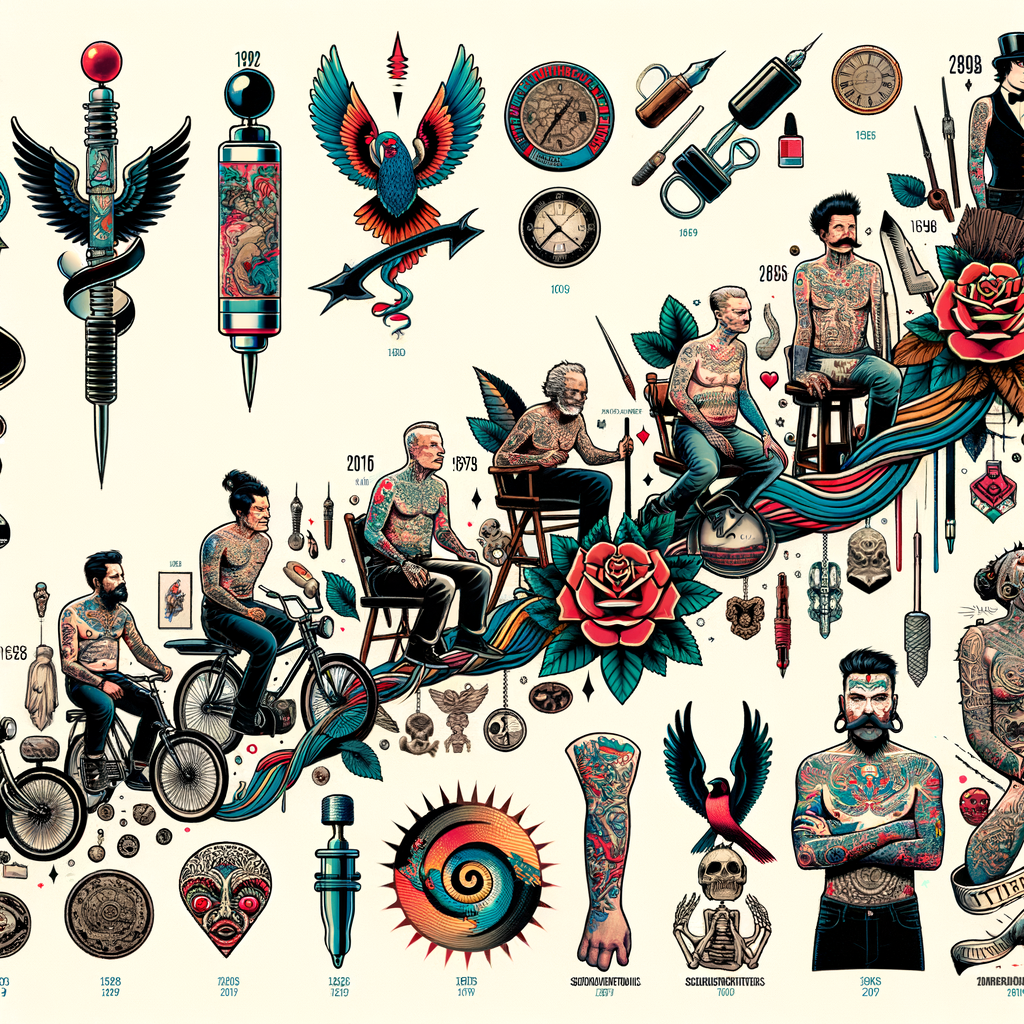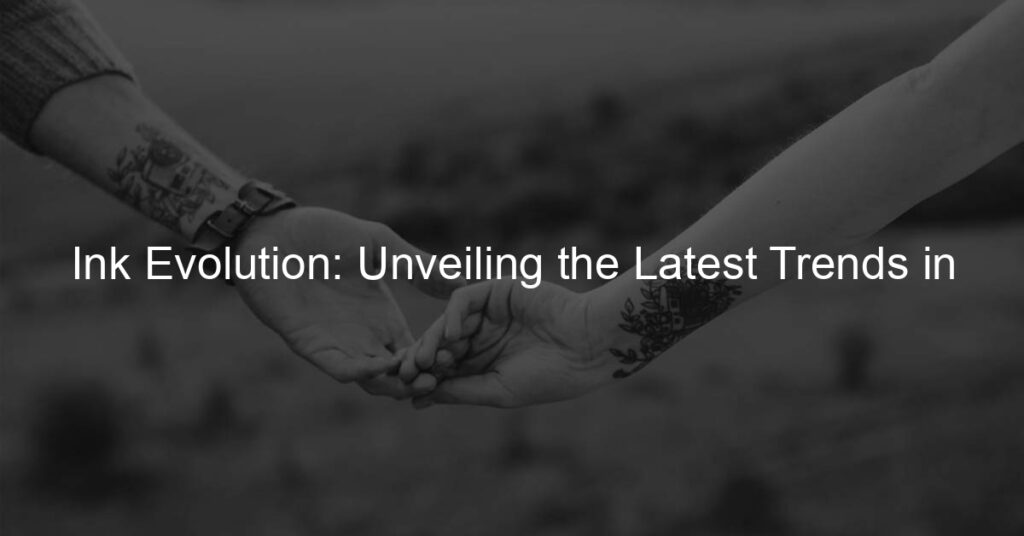
Introduction to Modern Tattoo Trends
Today, tattoos are more than just body art; they are a form of self-expression, a way to tell a story, and a reflection of one’s personality. This article will provide an overview of the current trends in tattooing and discuss the significance of tattoo culture evolution.
-
Overview of Current Trends in Tattooing
Tattooing has evolved significantly over the years, with new trends emerging and old ones being reinvented. Here are some of the most popular trends in the modern tattoo world:
- Minimalist Tattoos: These are simple, small, and subtle designs that are often done in black ink. They are popular for their understated elegance and versatility.
- Watercolor Tattoos: This style mimics the look of a watercolor painting, with soft edges and vibrant colors. It’s a unique and artistic approach to tattooing.
- Geometric Tattoos: These designs incorporate geometric shapes and patterns. They can be simple or complex, and often have a symbolic or spiritual meaning.
- Dotwork Tattoos: This technique uses tiny dots to create intricate designs. It’s a time-consuming process, but the end result is a highly detailed and unique piece of art.
-
Significance of Tattoo Culture Evolution
The evolution of tattoo culture is a reflection of societal changes and advancements in technology. In the past, tattoos were often associated with certain subcultures or seen as a sign of rebellion. Today, they are widely accepted and celebrated as a form of personal expression.
Modern tattoo trends also show a shift towards more artistic and unique designs, as well as a greater emphasis on individuality. This is largely due to advancements in tattooing techniques and equipment, which have allowed artists to create more detailed and intricate designs.
The evolution of tattoo culture also highlights the importance of understanding and respecting the origins and meanings of different tattoo styles. For example, tribal tattoos have a rich history and cultural significance, and it’s important to honor these traditions when incorporating them into modern designs.
In conclusion, the world of tattooing is constantly evolving, with new trends and styles emerging all the time. Whether you’re a tattoo enthusiast or just curious about the art form, it’s fascinating to see how this ancient practice has adapted and thrived in the modern world.
History of Tattooing
Let’s take a journey back in time to explore the fascinating history of tattooing. We will delve into its origins and how the techniques have evolved over the centuries.
- Origins of Tattooing
- Evolution of Tattooing Techniques Over the Centuries
The art of tattooing has been a part of human culture for thousands of years. The earliest evidence of tattoos dates back to the ancient Egyptians around 2000 BC. However, the discovery of the Iceman, a mummified human body from around 3300 BC, revealed tattoo patterns on his skin, suggesting that the practice could be even older.
Over the centuries, the techniques used for tattooing have significantly evolved. In the beginning, tattoos were made by hand, where the artist would puncture the skin with a needle and then smear ink into the wound. It was a slow and painful process.
In the 19th century, the first tattoo machine was invented, revolutionizing the art. This machine, similar to the ones used today, allowed for faster and more precise tattooing. Over time, the machines have been refined and modernized, leading to the high-quality, intricate designs we see today.
In conclusion, the history of tattooing is a rich tapestry that reflects the evolution of human culture and technology. From its ancient origins to the advanced techniques of today, tattooing remains a powerful form of personal expression and identity.
Trends in Tattoo Art Through the Ages
Throughout history, the art of tattooing has evolved significantly. Let’s take a closer look at the journey from traditional to modern tattoo styles.
- Traditional Tattoo Styles
- Transition to Modern Tattoo Styles
Traditional tattoo styles, often referred to as “Old School”, have a rich history. These designs are characterized by bold black outlines, solid colors, and iconic images like roses, hearts, and anchors. They were popularized in the Western world by sailors in the 19th century. The simplicity and boldness of these designs have stood the test of time, and they remain popular today.
| Traditional Tattoo Styles | Description |
|---|---|
| Anchor | Symbolizes stability and strong foundation. |
| Rose | Often represents love, beauty, and balance. |
| Heart | Typically signifies love, passion, and adoration. |
As tattooing techniques and equipment advanced, artists began to explore new styles. Modern tattoo styles emerged in the late 20th century, offering more detail, color variety, and complexity. Some popular modern styles include realism, watercolor, and geometric designs. These styles allow for more personal expression and creativity, making each tattoo unique.
| Modern Tattoo Styles | Description |
|---|---|
| Realism | Focuses on creating lifelike images with great detail and shading. |
| Watercolor | Imitates the fluid, vibrant look of watercolor paintings. |
| Geometric | Uses shapes and patterns for a visually striking effect. |
From the bold and simple designs of traditional tattoos to the intricate and personalized styles of modern tattoos, the art of tattooing continues to evolve. As we look to the future, we can expect to see even more innovation and creativity in this ancient art form.
Evolution of Tattoo Ink
Let’s take a journey through time to understand the evolution of tattoo ink. From its humble beginnings to the advanced innovations we see today, tattoo ink has undergone a significant transformation.
- Early forms of tattoo ink
- Advances in tattoo ink innovations
In the early days, tattoo ink was made from natural ingredients. People used things like charcoal, ash, and plant dyes. These ingredients were mixed with water to create a paste. This paste was then used as tattoo ink. The process was simple, but the results were not always perfect. The colors were often dull and faded quickly.
As time went on, people started to experiment with different materials to improve the quality of tattoo ink. They began to use minerals and metals to create vibrant and long-lasting colors. Today, tattoo ink is made from pigments and a carrier solution. The pigments provide the color, and the carrier solution helps to apply it evenly on the skin.
These advances in tattoo ink innovations have opened up a whole new world of possibilities. Tattoos are now more colorful, detailed, and expressive than ever before. They have become a form of art, a way to express one’s personality and individuality.
| Period | Type of Ink | Characteristics |
|---|---|---|
| Early Times | Natural Ingredients (Charcoal, Ash, Plant Dyes) | Dull colors, Faded quickly |
| Modern Times | Pigments and Carrier Solution | Vibrant colors, Long-lasting |
In conclusion, the evolution of tattoo ink has played a crucial role in the growth and development of tattooing as an art form. It has allowed artists to push the boundaries of creativity and has made tattoos more accessible and appealing to a wider audience.
Modern Ink Art: A New Era of Tattooing
As we delve into the fascinating world of modern ink art, we embark on a journey that showcases the transformation of tattooing from a traditional craft to a contemporary art form. This new era of tattooing is characterized by innovative techniques, vibrant colors, and unique designs that reflect personal stories and cultural influences.
- Introduction to modern ink art
- Impact of modern ink art on contemporary tattoo styles
Modern ink art is a revolutionary form of tattooing that has evolved significantly over the years. It is more than just a trend; it’s a form of self-expression that allows individuals to showcase their personality, beliefs, and experiences. Unlike traditional tattoos, modern ink art incorporates a variety of styles, techniques, and colors, resulting in unique and personal designs.
Modern ink artists are not just tattooists; they are creative visionaries who use the human body as their canvas. They experiment with different styles, from geometric patterns to watercolor designs, to create tattoos that are truly one-of-a-kind. The rise of modern ink art has also led to the development of new tattooing techniques, such as dotwork and blackwork, which offer a fresh and innovative approach to tattoo design.
The influence of modern ink art on contemporary tattoo styles is undeniable. It has paved the way for a more artistic approach to tattooing, encouraging artists to push the boundaries of traditional designs and techniques. This has resulted in a diverse range of tattoo styles, each with its own unique aesthetic and symbolism.
For instance, the popularity of geometric tattoos can be attributed to the rise of modern ink art. These designs, which often feature intricate patterns and shapes, are a testament to the precision and creativity of modern ink artists. Similarly, the watercolor tattoo style, characterized by its vibrant colors and brushstroke-like effects, is a direct result of the artistic innovation that modern ink art promotes.
Moreover, modern ink art has also influenced the way people perceive tattoos. They are no longer seen as mere body modifications, but as a form of personal expression and art. This shift in perception has played a crucial role in the acceptance and popularity of tattoos in contemporary society.
In conclusion, modern ink art has revolutionized the world of tattooing, introducing new styles and techniques that have transformed tattoos from traditional symbols to personal works of art. As we continue to explore the evolution of tattoo ink, it’s clear that the future of tattooing is bright, vibrant, and full of creative possibilities.
Contemporary Tattoo Styles
As we delve into the world of modern tattooing, it’s essential to understand the popular styles and emerging trends that are shaping the industry today. Let’s explore these captivating art forms.
- Popular styles in modern tattooing
- Realism: This style aims to create tattoos that look as lifelike as possible, often featuring portraits or nature scenes.
- Watercolor: These tattoos mimic the look of watercolor paintings, with bright colors and a lack of outlines.
- Geometric: Geometric tattoos use shapes and lines to create intricate patterns and designs.
- Traditional: Also known as “Old School,” this style features bold lines, bright colors, and iconic imagery like anchors, roses, and hearts.
- Emerging trends in tattoo art
- Minimalist Tattoos: These simple, understated designs are becoming increasingly popular for their elegance and subtlety.
- Dotwork: This style uses tiny dots to create intricate designs, often with a monochrome palette.
- Biomechanical: Inspired by science fiction, these tattoos mimic the look of machinery or robotics under the skin.
- Blackwork: This bold style uses large areas of solid black ink to create striking designs.
Modern tattooing is a vibrant and diverse field, with a plethora of styles that cater to different tastes and preferences. Some of the most popular styles include:
As tattooing continues to evolve, new trends are constantly emerging. Here are a few that are making waves in the industry:
Whether you’re a tattoo enthusiast or a curious observer, understanding these styles and trends can provide a deeper appreciation for the artistry and creativity that goes into every tattoo.
Case Study: The Rise of Minimalist Tattoos
Minimalist tattoos have become a popular trend in the world of tattoo art. Let’s explore the origins of this style and understand why it’s gaining popularity.
- Origins of minimalist tattoos
The minimalist tattoo style is not new. It has its roots in the ancient art of tattooing. The simplicity and elegance of minimalist tattoos can be traced back to indigenous cultures around the world. For example, Native American tribes used simple geometric designs in their body art.
However, the modern minimalist tattoo trend started gaining traction in the late 20th century. This was a time when people started to appreciate the beauty in simplicity. The minimalist art movement, which emphasizes the use of simple shapes and colors, also influenced this tattoo style.
- Why minimalist tattoos are trending
Minimalist tattoos are trending for several reasons. First, they are subtle and elegant. They can be a small symbol or a word that holds a deep meaning for the person. This makes them a popular choice for people getting their first tattoo.
Second, minimalist tattoos are versatile. They can be easily hidden or showcased, depending on the wearer’s preference. This flexibility is appealing to many people.
Third, minimalist tattoos are less time-consuming and painful to get. Since they usually involve less ink and simpler designs, the tattooing process is quicker and less intense.
Finally, minimalist tattoos are seen as a form of self-expression. They allow the wearer to convey a message or symbolize a personal belief or value in a subtle and stylish way.
| Reasons for the Popularity of Minimalist Tattoos |
|---|
| Subtle and Elegant |
| Versatile |
| Less Time-Consuming and Painful |
| Form of Self-Expression |
In conclusion, the rise of minimalist tattoos can be attributed to their simplicity, versatility, and the personal connection they offer. As more people continue to appreciate the beauty in simplicity, this trend is likely to continue growing.
Future of Tattooing
As we look ahead, the future of tattooing is filled with exciting possibilities. Let’s explore some of the predicted trends in tattoo art and future innovations in tattoo ink.
- Predicted trends in tattoo art
- Future innovations in tattoo ink
Experts predict that the world of tattoo art will continue to evolve and diversify. One trend that’s expected to gain popularity is the use of geometric patterns. These designs, inspired by sacred geometry, are not only visually striking but also carry deep symbolic meanings. Another trend on the horizon is the increased use of color. While black and grey tattoos have dominated the scene for a while, artists are now experimenting with a wider color palette to create more vibrant and realistic designs.
When it comes to tattoo ink, the future is all about safety and sustainability. Researchers are working on developing new types of ink that are not only safer for the skin but also more environmentally friendly. One such innovation is the development of bio-inks, which are made from natural pigments and are biodegradable. Another exciting development is the creation of ‘smart’ tattoo inks. These inks can change color in response to changes in the body, such as changes in blood sugar levels or body temperature, potentially offering a new way to monitor health.
As we move forward, it’s clear that the future of tattooing holds a wealth of exciting possibilities. Whether it’s new trends in design or innovative types of ink, the world of tattoo art is set to become even more diverse and dynamic.
Key Takeaways: The Evolution of Tattooing
-
Importance of Understanding the History of Tattooing
Understanding the history of tattooing is crucial for anyone interested in this form of body art. It’s not just about the designs and the colors; it’s about the story behind each mark. Tattooing has been a part of human culture for thousands of years, with the oldest known tattoo dating back to 3370 BC to 3100 BC. It was a form of expression, a rite of passage, and a symbol of status and identity. By appreciating its rich history, we can better appreciate the artistry and significance of modern tattoos.
-
Appreciating the Evolution of Tattoo Ink and Techniques
The evolution of tattoo ink and techniques is a fascinating journey. From the use of soot and ash in ancient times to the vibrant, safe, and long-lasting inks we have today, the progress is remarkable. Techniques have also evolved from hand-tapping to the use of electric tattoo machines, allowing for more intricate and detailed designs. This evolution reflects human innovation and creativity, and understanding it can deepen our appreciation for the art of tattooing.
Evolution of Tattoo Techniques and Inks Period Techniques Inks Ancient Times Hand-tapping Soot and Ash 19th Century Handheld Electric Machines Early Forms of Ink Present Day Modern Tattoo Machines Vibrant, Safe, Long-lasting Inks






